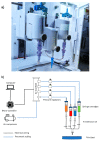Development of a Disposable Single-Nozzle Printhead for 3D Bioprinting of Continuous Multi-Material Constructs
- PMID: 32354128
- PMCID: PMC7281083
- DOI: 10.3390/mi11050459
Development of a Disposable Single-Nozzle Printhead for 3D Bioprinting of Continuous Multi-Material Constructs
Abstract
Fabricating multi-cell constructs in complex geometries is essential in the field of tissue engineering, and three-dimensional (3D) bioprinting is widely used for this purpose. To enhance the biological and mechanical integrity of the printed constructs, continuous single-nozzle printing is required. In this paper, a novel single-nozzle printhead for 3D bioprinting of multi-material constructs was developed and characterized. The single-nozzle multi-material bioprinting was achieved via a disposable, inexpensive, multi-fuse IV extension set; the printhead can print up to four different biomaterials. The transition distance of the developed printhead was characterized over a range of pressures and needle inner diameters. Finally, the transition distance was decreased by applying a silicon coating to the inner channels of the printhead.
Keywords: 3D bioprinting; continuous multi-material printing; multi-material printing; single-nozzle printing.
Conflict of interest statement
The authors declare no conflict of interest.
Figures





References
Grants and funding
LinkOut - more resources
Full Text Sources

